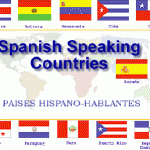Archives
now browsing by author
Border Livin’
A big part of living a walking distance from the border to Mexico, means that two different cultures, customs, foods, people, and of course, languages collide and begin to merge into one.
SPANGLISH
Although i am not completely in favor of the use of spanglish, it is something that gradually happens as two different countries collide. It is a mix of english and spanish by speakers who have at least a basic understanding of both. I am sure this is also the case in border towns across the world. Many people agree that it is acceptable to use it and even defend it by explaining there is also a right way of speaking it with rules and syntax. Others simply simply classify it as jargon that “uneducated” people use. It cannot be classified, however, as a pidgin because its history can be traced (Spanish and English) and is not an entirely new language. Not surprising, even Hollywod has acknowledged the fact that Spanglish is big, bg enough to make a movie starring Adam Sandler.
http://en.wikipedia.org/wiki/Spanglish
https://www.youtube.com/watch?v=HXkSBXrdDxs
SAN DIEGO/TIJUANA
For many, home isnt one house, one city, or even one country. It includes the best of both worlds! (Yes thats a Hannah Montana song reference…) These border towns are the most visited in the world, bringing and taking different slang, and shared words. In a car ride home, we can hear the news regarding traffic from Mexico into the US as so many people cross every day. Even local newspapers have sections for it enabling easier access.
http://pehemedia.com/wp-content/uploads/2013/04/tij-sd.jpg
http://en.wikipedia.org/wiki/Mexico%E2%80%93United_States_border
http://www.utsandiego.com/news/local-topics/border-baja/
LINGUISTICALLY DELICIOUS FOODS
As many people that have moved to beautiful San Diego from across the country, they have tasted the many finger licking good foods Mexico has to offer right here in the United States. Although many are authentic (or at least claim to be) Mexican foods, there are numerous Mexican dishes with a touch of American familiarity. (No, Taco Bell is not real Mexican food, but it is an Americanized version of it.) We see a mixture of spanish and english in the very foods we all enjoy such as carne asada fries, jalapeno poppers, fish tacos, chicken quesadillas, etc. Dont get me started on the Tostilocos…
http://www.singlepage.com/on-the-border-79/menu?ref=yahoo
http://dontheapron.wordpress.com/2012/02/22/street-food-at-the-tijuanasan-diego-border/
http://www.sandiegomagazine.com/San-Diego-Magazine/August-2014/Best-of-Tijuana/
http://ryanandelizabethshideler.blogspot.com/2012/01/food-friday-tostilocos.html
MAS LINKS INTERESANTES Y DELICIOSOS (More interesting and delicious links)
https://sp.yimg.com/ib/th?id=HN.607993290176990331&pid=15.1&P=0
http://www.traditional-mexican-culture.com/traditions-of-mexican-american-culture.html
It’s A Culture Thing – HW4
(Pg. 444)
14a. Phonological
b. Syntactic
c. Phonetic (?)
d. Semantic
e. Syntactic
f. Phonological
(Pg. 445)
16a. Some (Non-Native)
b. Natural
c. Non-Native (Some)
d. Some
e. Some
f. Non-native
g. Natural (Some)
h. Some (Natural)
i. Natural
j. Natural
k. Non-native
l. Some
m. Natural
n. Some
o. Non-Native
(Pg. 446)
17a. Bucket
b. Bag
c. Curtains, Blinds
d. Soda
e. Fireflies, Lightning Bugs
f. In Line
g. Clean It Up, Straighten It Up
h. You Guys
i. A Quarter Til 5, A Quarter To 5
(p479)
exercise
- what are some of the competencies that are part of communicative competence?
grammatical, socio-linguistic, strategic,discourse
- how does cultural competence differ from linguistic competence and from performance?
cultural has to do with the background of where you were raised with how you know how to use that intellect that you have acquired in that region which not have much significant change in linguistic competence rather performance because this is acquired through individuals which in essence would every from person to person.
- what is an adjacency pair? make a list of five adjacency pairs in american english not mentioned in the chapter.
adjacency pair is a unit of conversation that contains an exchange of one turn each by two speakers.
taking turns, question and answer, complaint ( excuse/remedy), degreeting, offer ( accept / reject)
(P480)
based on my own experience power relationship can be established by winning the person over by acting nice, helping them over and trying to bribe them in a established conversation. i think bribe can be indicative and acting nice as opposed to someone acquiescing. in my experience it can be inherited and socially because one without the other would not function right. its like the example of tea without the water. tea within it self is leafs but without the right format or right tools would not make it tea rather just plan leafs. that is why water is the essential in order to make tea what tea is.
(P482)
28)
- how i and my friend greeted today was how we did our homework today in linguistic 501 his response was “i forgot to type it” and “i said me too”.
- i ate tortoise today and prayed, talked about grammar and how linguistic 501 professor was funny.
- my instructor started class by pronouncing the word “e” in arabic and referring to it as an “and” and by talking about the non grammatical words that do not need to be there which included some words that i can’t mention which made me laugh really hard.
(P557)
- We know that there was a proto-Germanic language because, like Latin, we can see influences in many different languages that would all point back to this origin language.
- We spell words with a silent k even though we do not pronounce them because in Old and Middle English, these words pronounced the k. But, over time, English has been spoken with it, leading to the confusion.
(P561)
- Another example would be was and been for the “to be” verb.
(P562)
29)
- Old terms: mouse, the web, disks, desktop, google
New terms: flash drive, internal processor, laptop, youtube
We are able to associate certain computer lingo to real world items because they remind us of them, either visually or conceptually. But some things just do not remind us of anything that is already named, so we have to come up with a term for it based on what it is or how it performs.
- For the words in this list, I think that extension has occurred because our speech using those words has become so associated with computers that it is our natural instinct to think of the computer terms before the old terms, but the old terms are still there.
(P563)
33)
- Cynic: A member of a school of ancient Greek philosophersfounded by Antisthenes, marked by an ostentatiouscontempt for ease and pleasure. -Elevation
- Hacker: A person or thing that hacks or cuts roughly. -Reduction
- Anecdote: An accountregarded as unreliable or hearsay. -Reduction
- Grotesque: A style of decorativepainting or sculpture consisting of the interweaving of human and animal forms with flowers and foliage. -Degradation
- Parakeet: A smallparrot with predominantlygreenplumage and a long tail. -Reduction
- Leer: Look or gaze in an unpleasant, malicious, or lascivious way. -Degradation
- Captivated: Attract and hold the interest and attention of; charm. -Extension
- Paisley: A distinctiveintricatepattern of curved, feather-shaped figures based on a pine-conedesign from India. -Extension
(P513)
- Extensive borrowing is not a threat to a language. Languages will evolve on their own over time, as history has shown us. The borrowing of words from other languages will only help to advance the language as each “current” usage of the language is formed (i.e. from Middle English to Modern English).
(P516)
- I was only able to understand parts here and there and the overall meaning of the entire passage is difficult to understand. Questions have a consistent starting phrase, one in which English uses: “So now…”.
- This passage was fairly easy to understand. Many of the words used were English words, but some were not and so they needed the context of the English words to make sense. Words like “dees” and “islan” were easy enough to translate into “these” and “island” respectively.
(P517)
- Preventing endangered languages from dying out or reviving dormant languages would be a worthwhile, so long as the language would be taught as something more than simply ‘keeping a language alive’. Teaching people how to speak the Miami tribe language would help preserve the language, but would not serve much of a functional purpose beyond that. People would know the language, but would not use it to communicate at a regular rate. It would be like teaching 21st century Americans Middle or Old English: the language would still be around in the minds of those who knew the language, but they would only be able to communicate using it with other who knew the language, which would be far and few between.
Through time, we see that as people interact with others, their customs mix to make new ones, including language. Time, place, and people have a great impact on the very form of communication that makes us humans so unique. It is also narrowed to peoples race, age, sexuality, ethnicity, and community that makes language such a shared yet different phenomenon.
-By John Rivera, Muhammad Sabbir Abassi, and Raul Millan
The Mighty Morphemes
The Mighty Morphemes (TMM) is an international group working on issues regarding the conservation, research and linguistic, formerly named the Mighty Morphemes. TMM was founded in 2014.
Our symbol is simple and unique we are several individuals who are from different color. Ethnically we have variation in our language especially in English but our members are mostly native English speakers. Our venture in linguistic 101 is opening up our minds to semantics, phonology, phonology and more and we have learned a lot throughout the couple of months that have passed. As a group we enjoy making weird noises while holding our throats to classify sounds linguistically with our leisure time, which has made us as a group much stronger.

Mohammad Sabir Abbassi
Mohammad’s native language is farsi, second language is English and his third is Arabic. He did however speak Spanish, french and italian but over time he lost this ability since there was no one to speak to.
Raul Millan.
Age: 20
Height: 5’7
Weight: 140 lbs
Raul loves to read, play video games, and has a passion for soccer. Although he thinks it should be called futbol. His favorite movies include Star Wars, Indiana Jones, and Taken. In terms of linguistics, Raul’s strengths are semantics and syntax. He enjoys creating syntax trees out of random sentences to see how they interact with each other and create an infinite amount of sentences. He thinks that semantics are amazing because of the different meanings words can take. Being fluent in both English and Spanish is something he takes great pride in because he is 2 languages closer to learning the 7,105.

Seth Rubero
age: 18
Height: 5’9’’
Weight:160lbs
Seth enjoys long walks on the beach and getting caught in the rain… oh and linguistics too
Seth’s biggest weakness is semantics. Analyzing sentence structures has never been easy for him, but he’s working on it. Seth’s biggest strength is definitely morphology, affixes come naturally to him. His first language is English, but he has been studying Spanish since he was 15 years old and is now almost fluent. Being (almost) bilingual gives Seth a unique perspective on linguistics, and allows him to appreciate language more.

Kat Tharp
Age: 18
Height: 5’8”
Weight: 125 lbs
After spending 18 years braving the cold New Hampshire winters, Kat decided to try the most drastic change of scenery possible and move to San Diego, CA. Kat is a native English speaker, but has been studying Spanish since middle school and has become practically fluent over the years. But don’t she doesn’t plan to stop there; Kat has many languages she hopes to learn over the years. She plans to one day travel the world teaching the English language and learning about other languages and cultures all around the world. While morphology is her strong suit, Kat tends to get stuck on trees. Especially those of the syntax variety. But that won’t stop her from doing what she can to become a strong linguist.

Stellan Christensen is the name, Linguistics is the game.
Age: 18 ½
Height: 5’ 7”
Weight: 155 lb
Stellan was born and raised in Minneapolis, MN. Born from an American Dad and a Swedish Mother. He lived in Sweden when he was in 6th grade and acquired the language and knowledge of the heritage. He has played hockey and soccer for 10 years and he loves the sport. Stellan’s Idols include: Nathan Mackinnon, Mark Cuban, Johnny Manziel and Zlatan Ibrahimovic. He is currently a graphic design major at SDSU and he loves to have fun with family and friends.

Name: Sydnie Gilinsky
Age: 19
Height: 5’4”
Weight: 120 Lbs
Sydnie hails from the suburbs of Oregon, finding refuge now under the towering palms and sweet breezes of San Diego. She is a starving English major with a knack for poetry but some disdain for structure. That being acknowledged, Syntax harbors the most crucial struggle for her. Speaking Spanish for 5 years should lend her a helping hand in certain areas, however she has not yet figured out exactly how she can apply these skills. Nonetheless, linguistics fosters a few areas crucial to her skillset, such as exploring phonetics and phonology, as well as the basic design features and theories of language. Sydnie finds that the idea of language at its core being universal is both a fascinating and horrifying idea, but trudges on in the battle to better understand the cogs of linguistics.





 D5 Creation
D5 Creation